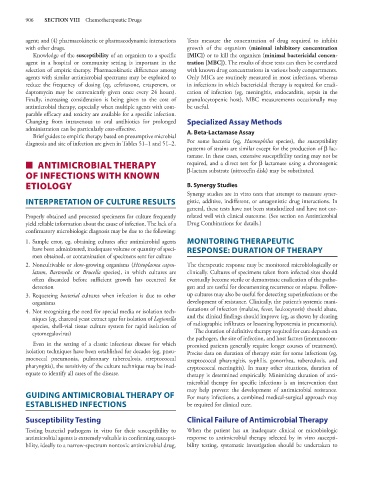Page 920 - Basic _ Clinical Pharmacology ( PDFDrive )
P. 920
906 SECTION VIII Chemotherapeutic Drugs
agent; and (4) pharmacokinetic or pharmacodynamic interactions Tests measure the concentration of drug required to inhibit
with other drugs. growth of the organism (minimal inhibitory concentration
Knowledge of the susceptibility of an organism to a specific [MIC]) or to kill the organism (minimal bactericidal concen-
agent in a hospital or community setting is important in the tration [MBC]). The results of these tests can then be correlated
selection of empiric therapy. Pharmacokinetic differences among with known drug concentrations in various body compartments.
agents with similar antimicrobial spectrums may be exploited to Only MICs are routinely measured in most infections, whereas
reduce the frequency of dosing (eg, ceftriaxone, ertapenem, or in infections in which bactericidal therapy is required for eradi-
daptomycin may be conveniently given once every 24 hours). cation of infection (eg, meningitis, endocarditis, sepsis in the
Finally, increasing consideration is being given to the cost of granulocytopenic host), MBC measurements occasionally may
antimicrobial therapy, especially when multiple agents with com- be useful.
parable efficacy and toxicity are available for a specific infection.
Changing from intravenous to oral antibiotics for prolonged Specialized Assay Methods
administration can be particularly cost-effective. A. Beta-Lactamase Assay
Brief guides to empiric therapy based on presumptive microbial
diagnosis and site of infection are given in Tables 51–1 and 51–2. For some bacteria (eg, Haemophilus species), the susceptibility
patterns of strains are similar except for the production of β lac-
tamase. In these cases, extensive susceptibility testing may not be
■ ANTIMICROBIAL THERAPY required, and a direct test for β lactamase using a chromogenic
β-lactam substrate (nitrocefin disk) may be substituted.
OF INFECTIONS WITH KNOWN
ETIOLOGY B. Synergy Studies
Synergy studies are in vitro tests that attempt to measure syner-
INTERPRETATION OF CULTURE RESULTS gistic, additive, indifferent, or antagonistic drug interactions. In
general, these tests have not been standardized and have not cor-
Properly obtained and processed specimens for culture frequently related well with clinical outcome. (See section on Antimicrobial
yield reliable information about the cause of infection. The lack of a Drug Combinations for details.)
confirmatory microbiologic diagnosis may be due to the following:
1. Sample error, eg, obtaining cultures after antimicrobial agents MONITORING THERAPEUTIC
have been administered, inadequate volume or quantity of speci- RESPONSE: DURATION OF THERAPY
men obtained, or contamination of specimens sent for culture
2. Noncultivable or slow-growing organisms (Histoplasma capsu- The therapeutic response may be monitored microbiologically or
latum, Bartonella or Brucella species), in which cultures are clinically. Cultures of specimens taken from infected sites should
often discarded before sufficient growth has occurred for eventually become sterile or demonstrate eradication of the patho-
detection gen and are useful for documenting recurrence or relapse. Follow-
3. Requesting bacterial cultures when infection is due to other up cultures may also be useful for detecting superinfections or the
organisms development of resistance. Clinically, the patient’s systemic mani-
4. Not recognizing the need for special media or isolation tech- festations of infection (malaise, fever, leukocytosis) should abate,
niques (eg, charcoal yeast extract agar for isolation of Legionella and the clinical findings should improve (eg, as shown by clearing
species, shell-vial tissue culture system for rapid isolation of of radiographic infiltrates or lessening hypoxemia in pneumonia).
cytomegalovirus) The duration of definitive therapy required for cure depends on
the pathogen, the site of infection, and host factors (immunocom-
Even in the setting of a classic infectious disease for which promised patients generally require longer courses of treatment).
isolation techniques have been established for decades (eg, pneu- Precise data on duration of therapy exist for some infections (eg,
mococcal pneumonia, pulmonary tuberculosis, streptococcal streptococcal pharyngitis, syphilis, gonorrhea, tuberculosis, and
pharyngitis), the sensitivity of the culture technique may be inad- cryptococcal meningitis). In many other situations, duration of
equate to identify all cases of the disease. therapy is determined empirically. Minimizing duration of anti-
microbial therapy for specific infections is an intervention that
may help prevent the development of antimicrobial resistance.
GUIDING ANTIMICROBIAL THERAPY OF For many infections, a combined medical-surgical approach may
ESTABLISHED INFECTIONS be required for clinical cure.
Susceptibility Testing Clinical Failure of Antimicrobial Therapy
Testing bacterial pathogens in vitro for their susceptibility to When the patient has an inadequate clinical or microbiologic
antimicrobial agents is extremely valuable in confirming suscepti- response to antimicrobial therapy selected by in vitro suscepti-
bility, ideally to a narrow-spectrum nontoxic antimicrobial drug. bility testing, systematic investigation should be undertaken to

